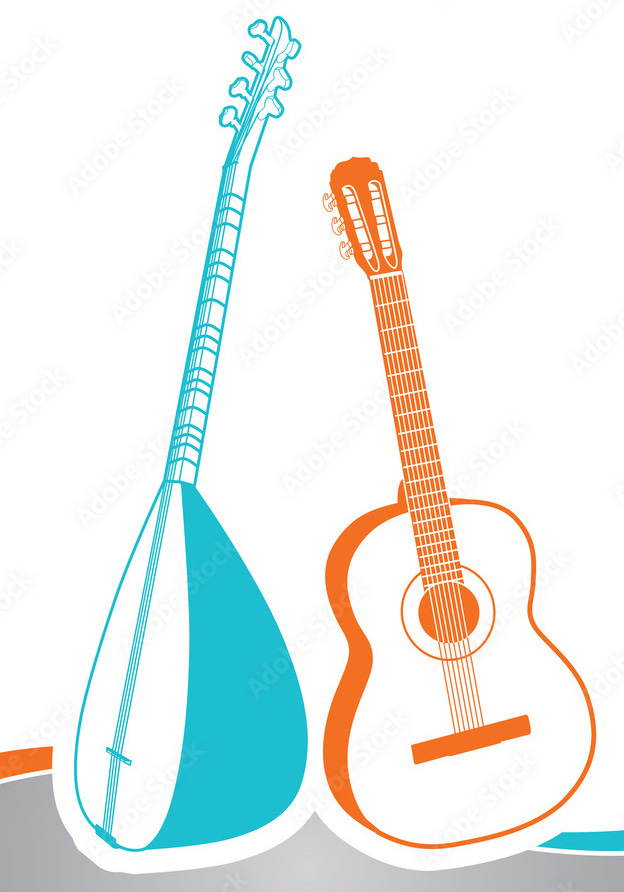PS: This article is about music. If you would like to read the article with the accompaniment of the music it discusses, here is my Youtube playlist: Microtonality by Amateur Polymath
Many of my articles (as well as the subjects of my master’s degree) focus on negative impacts of technology. Instead, today I want to posit a more positive view of how technology sometimes enables us to break out of our human-made limitations. The following is the story of how Western music put itself in a box by standardizing its instruments, and how new technological innovations are helping us reshape (if not break) that box.
There are songs, even simple melodies from my hometown, that I cannot play on my guitar. Indeed, even the most skillful guitarist could not play these melodies on a run of the mill Yamaha. Not because these are complex melodies; they have been played by musicians, professional and amateur, for centuries. Instead, the difficulty lies in the guitar itself. My guitar, just like most guitars produced after the 19th century, has frets placed in every "semi-tone", and they cannot reproduce the "micro-tones" employed in the melodies of Anatolian folk music. If I took myself more seriously, I would call this: The notes lost between the frets.
Here is a set of standards so entrenched in society that we rarely contemplate its alternatives: The modern guitar is divided vertically by frets segmented uniformly across the strings, each fret creating a pitch a semi-tone apart from its neighbors. In fact, even the term “micro-tonality” denotes that our musical brains have been Western-standardized. Anatolian music, as well many traditions of music from all around the world, use different tuning systems (cool examples here). Early guitars in the West allowed this variety in music theory. Lutes had movable frets, and Spanish vihuelas had fixed frets that were arranged differently than the semi-tonal structure of the modern guitar. Up until the 19th century, it would have been possible to find two guitars next to each other that did not share the same fret arrangements; two guitars that could produce different notes from one another.

In the 19th century, European musicians found the need to standardize tuning systems in order to accommodate ensemble performances and standardize music education across various institutions. They landed on the "12 Tone Equal Temperament" (12 TET) system, informally called semi-tonal tuning. All this means is that in most Western instruments, the narrowest pitch difference between any two notes is a semi-tone. Think, C to C#, or any two adjacent keys on a piano — they are a semi-tone apart (“100 cents”, if you want to be technical). While this standardization of tuning allowed for uniformity between Western instruments, it also meant sacrificing the possibility of playing intervals narrower than a semi-tone. There is nothing inherent or natural about picking the semi-tone as your standard unit. In fact, the human ear on average can detect a pitch difference of 5 cents. This means that there could be 20 notes between C and C# that we could differentiate between if we were accustomed to it. Due to European standardization of tunings, these notes are irreproducible in the modern guitar (and many other instruments).
The adoption of the 12 TET system was a matter of optimization, not perfection. Rather than providing an ideal solution to the mathematical relations that produce intervals, its aim was to approximate each interval adequately, but none of them perfectly. In fact, many notable compositions prior to this standardization, including the majority of Bach's compositions, were performed in different tunings. Standards tend to work well for the groups that establish them, but end up harming those in the periphery. So, while Bach's music was re-constructed to fit 12 TET, much of non-Western music that had traditions of alternate tuning systems ended up becoming "endangered biodiversity", at risk of erosion unless preserved.
However, rather than tell a story of how Western standardization of musical instruments hurt non-Western traditions, I would like to focus on an unlikely revival. In contemporary rock music, there is an emerging movement towards “un-standardization”, taking its roots from the Anatolian bağlama, the notes of which my modern guitar cannot reproduce.
In 2017, the Australian rock band King Gizzard and the Lizard Wizard made the album Microtonal Flying Banana, which brought microtonality to the rock mainstream. The album is named after the guitar they had to “mutate” (their words, not mine) so that they could move past the 19th century European ghosts. Guitarist Stu Mackenzie purchased and modified a cheap guitar to install new frets at the quarter notes, allowing him to play notes at a pitch distance of 50 cents. With the banana, they were able to play the tunes inspired by non-Western traditions. My personal favorite is Sleep Drifter, a tune inspired by Turkish bağlama legend Aşık Veysel’s Kara Toprak.
Mackenzie credits his dad's left-handed guitars as the thing that got him away from the standards of the average guitar. He saw that when the instrument was different, what you ended up creating was different too. Every song on this album would have been structurally impossible if it wasn't for the flying banana he fashioned. In an interview, he said: “Holy shit, I can write again, I feel free. Everything feels new on this thing, everything is fresh and exciting, I can play this note. It’s in between other notes, and it just sounds different, and it’s blowing my mind.’”
Of course, the average Joe is unlikely to have the resources and the skills required to just take a guitar and manipulate its structure. Although it’s not perfect, there’s are actually technological innovations that seek to make microtonal music accessible. For example, Tolgahan Cogulu has spent the last decade making adjustable microtonal frets that can be added to a classical guitar. Musicians like Jacob Collier and Adam Neely use musical composition software to play around with microtonality, and others like David Bennett use social media platforms to popularize microtonality to larger audiences. This time, technological innovations are used not to restrict, but to widen the field of creativity.
The adjustable microtonal guitar by Tolgahan Çoğulu
Two centuries ago, the European standardization of the 12 Tone Equal Temperament tuning system sidelined so many non-Western musical traditions, from the Anatolian music of my home, to Indian, Arabic, East Asian, South-East Asian, and tons of African traditions. Today, a wave of technological innovations and experimental musicians are challenging the standards, and the limitations, of this system. Back then, it was standardization that suppressed microtonal traditions. Today, it is un-standardizing innovations that revive them. So… cheers to un-standardization!

PS: I met Tolgahan in Boston a few years ago, and he is awesome! Check out his Instagram. Also, here is a Youtube playlist with all the songs mentioned and more.
Amateur Polymath - Microtonality Youtube Playlist
King Gizzard and the Lizard Wizard’s Microtonal Flying Banana
Jacob Collier’s famous G Half Sharp Chord
Adam Neely’s Microtonal Lo-Fi Hip-Hop
Tolgahan Çoğulu’s Microtonal Guitar
David Bruce’s video on different tonalities







He’s back! Great article, and great subject. I think it’s interesting enough to mention that the “ultimate goal” is to play the intervals of the harmonic series (1/1, 1/2, 1/3, 1/4, 1/5...), which is where “harmony” comes from, but we have to quantize them somehow and there’s lots of approaches to that, which results in many tuning systems.
I remember Tolgahan!!!